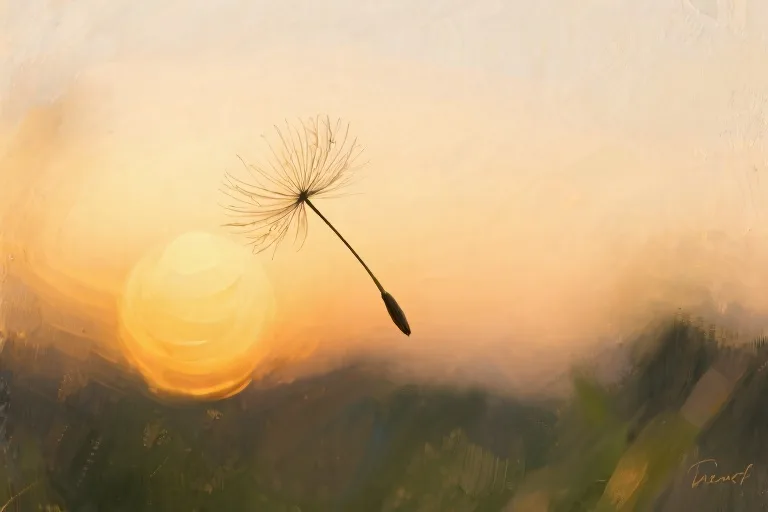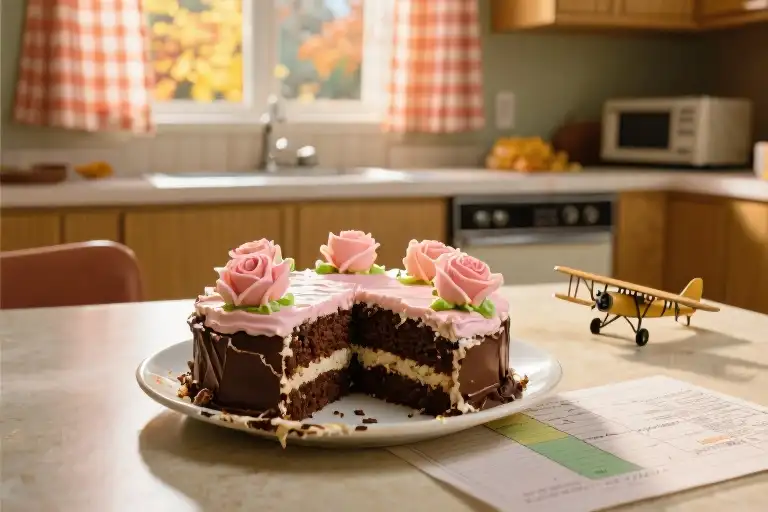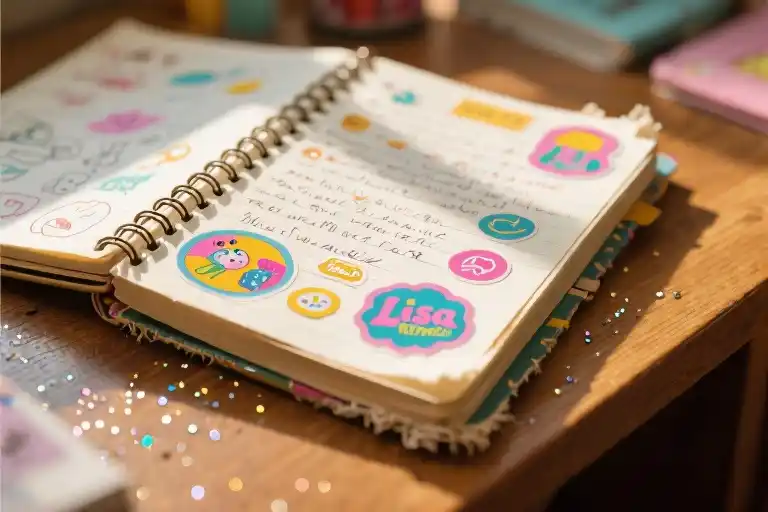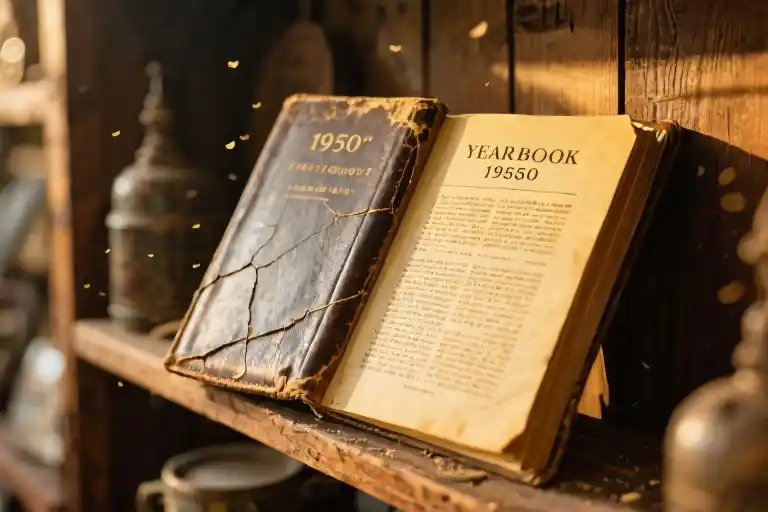The cigarette smoke curled lazily in the late afternoon air as I leaned against the porch railing. That’s when I noticed it – a dandelion clock reduced to its last remaining seed, its white parachute trembling slightly in the breeze. One stubborn survivor clinging to the stem where dozens had once clustered.
At forty-one, I’d forgotten how to make wishes on dandelions. The childhood magic had faded somewhere between mortgage payments and grocery lists. Yet there it was – that single seed refusing to let go, triggering something deeper than nostalgia. My fingers remembered before my mind did, automatically curling into the same shape they’d made decades ago when my grandmother first taught me this ritual.
Memory works in strange ways. The scent of tobacco mixed with cut grass shouldn’t have transported me back to her backyard, yet suddenly I was six years old again, kneeling beside her in the summer sunlight. She never called them weeds, my grandmother. Where neighbors saw lawn invaders, she saw tiny wish factories waiting to be activated. “They’re nature’s birthday candles,” she’d whisper conspiratorially, as if sharing classified information. “But you only get one wish per dandelion, so make it count.”
That last seed swayed precariously, caught between gravity and breeze. I found myself holding my breath, the way you do when watching a tightrope walker. Part of me wanted to leave it untouched – this final wish preserved like a museum exhibit. The other part remembered grandmother’s hands guiding mine, showing me how to cup the stem just so, how to exhale with controlled precision. “Not too hard now,” she’d caution, “or you’ll blow the magic right out of them.”
Modern life had turned such moments into relics. We schedule happiness now, slotting joy between meetings and chores. But standing there with smoke curling from my forgotten cigarette, I understood why this memory survived when so many others had faded. It wasn’t just about dandelions – it was about being seen. Really seen. The way grandmother noticed not just the flower, but my wonder at it. The way she honored that wonder by turning it into ceremony.
The seed finally detached as a stronger gust swept the porch, carrying it past my shoulder toward the lawn below. Somewhere between my lips parting and the seed disappearing from view, I’d made a wish without deciding to. The realization made me smile – forty-one years old, secretly hoping a plant could grant wishes. Maybe we never completely outgrow magic; we just stop admitting we believe in it.
Memory works like dandelion seeds – fragments that float back when least expected, taking root in surprising places. That lone survivor had unearthed something I thought time had buried: not just the memory, but the capacity for that particular flavor of hope. The cigarette had burned down to the filter, its ash joining the dandelion’s lost seeds somewhere in the grass. I crushed it out, making a mental note to check the lawn tomorrow. One seed was all it took to start the cycle again.
The Dandelion Pact
She never stood taller than when kneeling in the grass. My grandmother’s sun-freckled hands would part the blades like a curtain revealing backstage magic, her cotton dress pooling around her as if the earth itself was drawing her closer. “There,” she’d whisper, pointing to the fuzzy white globe I’d walked past a hundred times without seeing. “That’s not a weed – that’s a wishing machine.”
Children possess an innate understanding of wish logistics. The physics were clear in my six-year-old mind: the harder you blew, the farther the seeds traveled, therefore the higher your wish’s success rate. Grandma calibrated this delicate operation with the precision of a NASA engineer. “Not too hard now,” she’d caution, guiding my small hands to cradle the stem just so. “Wishes need breathing room.” Her own breath carried the scent of Earl Grey and peppermints, a comforting aroma that still makes me inhale deeply when I catch it unexpectedly.
Our ritual had exact parameters. Three seconds of eye contact with the chosen seed head to establish intent. A slow inhale through the nose (“Wishes grow in belly air”). Then the sacred exhale – lips pursed like playing a flute, airflow controlled to achieve maximum seed dispersion without spittle contamination. Success sent dozens of tiny parachutes swirling, each carrying a fraction of my childhood desires: more strawberry popsicles, a talking dog, for Grandpa to stop coughing at night.
The dandelion always got the last word. That milky sap oozing from the plucked stem left stubborn stains on her apron and my fingertips, nature’s receipt for wishes processed. Grandma would laugh as I tried rubbing the sticky residue on my jeans. “That’s the magic sticking to you,” she’d say. Decades later, I catch myself examining my fingers after handling dandelions, half-expecting to find traces of that luminous glue still connecting me to her.
We perfected our technique through countless summer afternoons, the lawn becoming a constellation of bald stems marking spent wishes. Sometimes she’d pluck one herself when she thought I wasn’t looking. I never asked what a grown woman wished for – perhaps she was stocking up on wishes to spend on me later. The year chemotherapy made her too weak to kneel, we adapted by transplanting dandelions into chipped teacups by her bedside, their stubborn roots refusing to acknowledge they didn’t belong in porcelain.
Modern psychology might call this ‘sensory memory’ or ’emotional anchoring.’ Grandma would’ve called it nonsense. “You’re overthinking the dandelion,” I can almost hear her say as I write this, her voice carrying that particular blend of amusement and exasperation she reserved for adult foolishness. The magic wasn’t in the plant’s biology but in the kneeling, the shared breathing, the sticky-fingered aftermath – the unspoken pact between believer and enabler that this ordinary thing could be extraordinary.
Lawn care commercials still portray dandelions as green-space invaders to be eradicated. I see them differently – as the last surviving messengers from a time when wishes weren’t childish things but vital currency, when someone I loved taught me that magic grows in the most unexpected places. All it takes is someone willing to kneel in the grass with you and say, “There. Do you see it now?”
The Theology of Weeds
The neighbors called them invaders – those golden-headed trespassers that dared dot their manicured lawns. Mr. Henderson next door would patrol his grass with a vinegar spray bottle every Saturday, muttering about property values as he executed each fuzzy offender. To most adults in our subdivision, dandelions were botanical delinquents that needed eradicating.
Yet there was my grandmother, kneeling on the checkered picnic blanket with me, treating each dandelion like a fallen star we’d been chosen to catch. “Look at how perfect this one is,” she’d say, rotating the stem between her fingers like a jeweler appraising a diamond. The afternoon sun would catch in the white puffball, making it glow like something holy. Where others saw nuisance, she saw possibility.
This radical reappraisal of weeds became my first lesson in perspective. The same plant could be either:
- A lawn’s worst enemy
- A child’s first wish-granting genie
depending entirely on who held it in their hands. My grandmother performed this alchemy regularly – transforming:
- Milkweed pods into nature’s Christmas ornaments
- Clover patches into four-leafed treasure maps
- Fallen acorns into fairy tableware
Her secret wasn’t magic but attention. She noticed what others walked past. Where hurried adults saw a messy yard, she showed me an entire universe of tiny miracles waiting to be witnessed.
Now, decades later, I understand the deeper rebellion in her botany lessons. In a world increasingly obsessed with:
- Efficiency over wonder
- Productivity over presence
- Perfect lawns over joyful moments
her dandelion diplomacy was quietly revolutionary. Each time we blew seeds into the wind, we weren’t just making wishes – we were declaring that some things are more valuable than neatness. That memory and meaning could take root anywhere, even in what society dismisses as weeds.
Today, watching that lone seed cling to its stem, I realize modern life has become one long weedkiller spray. We’ve been taught to:
- Schedule instead of wander
- Document instead of experience
- Filter instead of feel
Our mental herbicides eliminate anything that doesn’t contribute to productivity, leaving emotional landscapes as sterile as chemically-treated lawns. No wonder so many of us feel disconnected – we’ve been systematically removing the very things that make life stick to our souls.
That surviving dandelion seed on my porch isn’t just a memory trigger – it’s a resistance fighter. Proof that despite all our efficiency, some fragments of wonder still escape eradication. The milky sap on its stem is the same substance that stained my grandmother’s apron when she taught me to blow gently. The same substance that, in some alternate universe, might be dripping onto a child’s fingers right now as another grandmother whispers the secret of wishes into small, believing ears.
Perhaps this is why the memory surfaced now – not just as nostalgia, but as a reminder that wonder isn’t something we outgrow, but something we unlearn. That the difference between a weed and a treasure is never about the plant itself, but about who takes the time to really see it.
The Science of Sticky Memories
That lone dandelion seed did more than trigger nostalgia—it performed a perfect excavation of buried childhood magic. While countless memories fade, why do certain moments cling with such tenacity? The answer lies in how our brains encode experience.
Multisensory Anchors
Neuroscience confirms what grandmothers intuitively knew: memories attached to multiple senses survive longest. The dandelion ritual engaged:
- Touch: Milky sap coating small fingers
- Sound: Whispered instructions at ear-level
- Sight: Fluffy seed parachutes catching sunlight
- Smell: Fresh-cut grass beneath bare knees
- Taste: Inadvertent bitterness from stem-chewing
This sensory symphony created what researchers call elaborative encoding—the brain’s method of weaving memories through neural networks like embroidery thread. Contrast this with my cigarette’s solitary smoke signal, a one-dimensional trigger lacking emotional embroidery.
The Contrast Principle
Modern life manufactures poor memory triggers:
| Childhood Triggers | Adult Triggers |
|---|---|
| Dandelion wishes | Calendar alerts |
| Hand-squeezed lemonade | Keurig pods |
| Grandma’s embroidered hankies | Disposable tissues |
We’ve replaced multisensory experiences with transactional ones. The dandelion memory persists precisely because it represents an increasingly rare phenomenon—an unhurried, tactile moment of intergenerational connection.
Emotional Viscosity
Memory retention follows an emotional ‘stickiness’ scale:
- Neutral → Forgot yesterday’s coffee order
- Mildly pleasant → Recall favorite breakfast cereal
- Highly emotional → Remember first bicycle fall
- Sensory-rich bonding → Never forget dandelion lessons
This explains why we remember childhood magic while forgetting last week’s work meetings. Emotional viscosity turns memories into mental Post-it notes that withstand life’s weathering.
The Proust Effect
That sudden rush of memory has a name—involuntary autobiographical memory—triggered when present sensations mirror past encoding. Marcel Proust described it with madeleines; we experience it with:
- Certain song melodies
- Old book smells
- Specific fabric textures
- And yes, dandelion fluff
These triggers bypass rational recall, delivering emotional time travel. My smoking hand remembered the dandelion stem’s ridges before my conscious mind did—proof of deeply grooved neural pathways.
Memory Preservation Tips
To cultivate more ‘sticky’ memories:
- Engage multiple senses during meaningful moments
- Create small rituals around ordinary objects
- Slow down during emotional exchanges
- Document experiences through touch (pressing flowers) rather than just photos
That stubborn dandelion seed clinging to its stem mirrors how potent memories resist erosion. In our age of digital overload, such organic memory keepers become increasingly precious—tiny time capsules waiting to be unearthed by the right sensory key.
The Seed That Remains
The porch light catches the last dandelion seed still clinging to its stem as I exhale cigarette smoke into the evening air. Forty-one years dissolve in that moment – the rough wood of the railing beneath my elbows becomes the scratchy fabric of my childhood overalls, the bitter tobacco taste transforms into the milky sap I’d gotten on my tongue from blowing too hard.
Memory works like…
Like this stubborn seed that refuses to join its departed siblings. Like how my grandmother’s voice still whispers through decades when the wind catches a dandelion clock just right. The scientists call it ‘involuntary memory’ – those unsummoned flashes that arrive complete with sensory details we didn’t know we’d preserved. Proust had his madeleine; we common folk have our dandelions.
I stub out the cigarette and crouch down, the motion making my knees protest in a way my eight-year-old self would find hilarious. Up close, the seed’s parachute filaments glow like spider silk in the fading light. Somewhere between my grandmother’s hands guiding mine and this moment, I’d forgotten how to believe in wishes carried on the wind. Yet here persists this last ambassador from that lost country of childhood magic.
As I straighten up, something catches my eye near the porch steps – three new dandelion seedlings pushing through a crack in the pavement. The cycle continues whether we remember how to wish or not. Maybe tomorrow I’ll show some neighborhood kid how to make a proper childhood wish, the way my grandmother taught me. Or perhaps I’ll simply let the wind carry these new seeds wherever it pleases, trusting they’ll find their way to someone who still remembers how to believe.
Memory works like dandelions – burying themselves in forgotten corners only to bloom unexpectedly when conditions are just right. What unexpected seedlings might take root in your life today?





